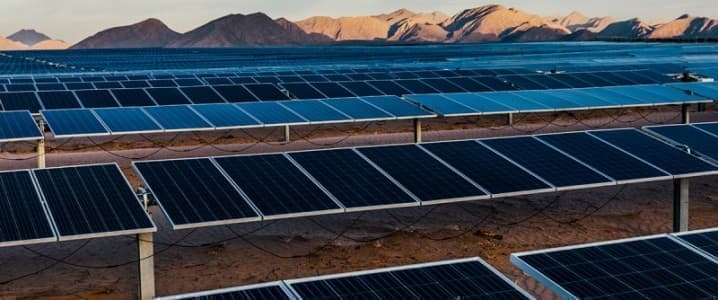The Middle East, North and West Africa are some of the world’s most important fossil fuel hubs, producing nearly half of the planet’s oil and gas. Hardly surprisingly, resource-rich countries tend to have little to no interest in renewable energy, with the exception of countries like Saudi Arabia and the United Arab Emirates which are currently developing some of the world’s biggest renewable energy projects.
One Arab nation is, however, quickly positioning itself as a potential supplier of renewable energy to energy-hungry Europe: Morocco. Although the North African country is not as well endowed with oil and gas as its neighbors, it has managed to develop a vibrant solar energy sector by taking advantage of year-round sunshine, wide open spaces for infrastructure projects and access to abundant development funding by Europe. Located on Europe’s doorstep and harboring ambitions to generate 52% of its electricity from renewables by 2030, Morocco has emerged as a promising energy partner.
In 2016, Spain, France, Portugal and Germany signed a Joint Declaration with Morocco for future cooperation on renewable energy. Spain has also been upgrading its submarine connection to the Moroccan electrical grid. Earlier this year, the EU pledged €624 million ($688.6 million) in funding to support Morocco’s green energy transition. The transition requires substantial investment, with the country needing an estimated $52 billion to achieve its 2030 targets. Currently, Morocco imports more than 90 percent of its energy, mostly from fossil fuels. Related: Why Gasoline Prices Fall Almost Every Year Between August and November
The world's largest concentrated solar project will be the Noor Ouarzazate Solar Complex. The 580 MW power plant under development is situated 10 km northeast of Ouarzazate. Large rotating mirror arrays, commonly referred to as heliostats, are used in CSP technology to focus and reflect sunlight onto a receiver. To reflect sunlight onto a sizable solar receiver, the mirrors are tilted. This heat, also referred to as thermal energy, can be used to power a number of industrial processes, such as enhanced oil recovery, mineral processing, water desalination, chemical production, and food processing that is done far from the point of harvesting. It can also be used to spin a turbine or power an engine to generate electricity.
Meanwhile, Morocco is developing a giant 300 MW wind farm in Tarfaya, just across the border from the Western Sahara. The wind farm is the largest in Africa.
Greenwashing Western Sahara occupation?
But Morocco's clean energy sector has one little dirty secret: it’s largely powered by the occupied Western Sahara territory. Western Sahara is a disputed territory on the northwest coast of Africa, with 20% of the territory controlled by the self-proclaimed Sahrawi Arab Democratic Republic while 80% of the territory is occupied and administered by neighboring Morocco. With a surface area of 266,000 square kilometers and a population of just 587,000, Western Sahara offers vast swathes of sparsely populated land that Morocco has exploited for its green energy projects. The NGO Western Sahara Resource Watch has revealed that ~81% of the land allocated for such projects will be located in Western Sahara territory which Morocco annexed in the 1970s.
Indeed, Morocco has gone to great lengths to try and buy the acquiescence and cooperation of its European energy partners, who consider its occupation of Western Sahara illegal. A few weeks ago, Politico featured the “Qatargate” scandal that delves into how Qatari and Moroccan lobbyists bribed their way into the European parliament.
“The Moroccan monarchy is trying to greenwash its occupation. It is trying to present itself as a leader in the energy transition, but most of its new projects are in the Western Sahara. By involving foreign companies, like Siemens, they are making Europe complicit and creating a sense of normalcy in the occupation,” Mahfoud Bechri, the coordinator of the Western Sahara is Not for Sale campaign (WSNS), has lamented.
The EU has explicitly said that it would not import energy from the territory due to the status of the Western Sahara. In fact, no country has officially recognized the occupation as legitimate—though some do in practice. It’s going to be interesting to see how the EU will separate imports from Morocco proper and the occupied territories even as it continues to pump in millions of dollars into the Moroccan clean energy sector.
By Alex Kimani for Oilprice.com
More Top Reads From Oilprice.com:
- China Issues Additional Fuel Import Quotas
- ESG Moment of Truth Turns Tables for Big Oil
- OPEC Source Tells Reuters Bigger Cuts A Likely Option


















